
private-ml-sdk
Run LLMs and agents on TEEs leveraging NVIDIA GPU TEE and Intel TDX technologies.
Stars: 80
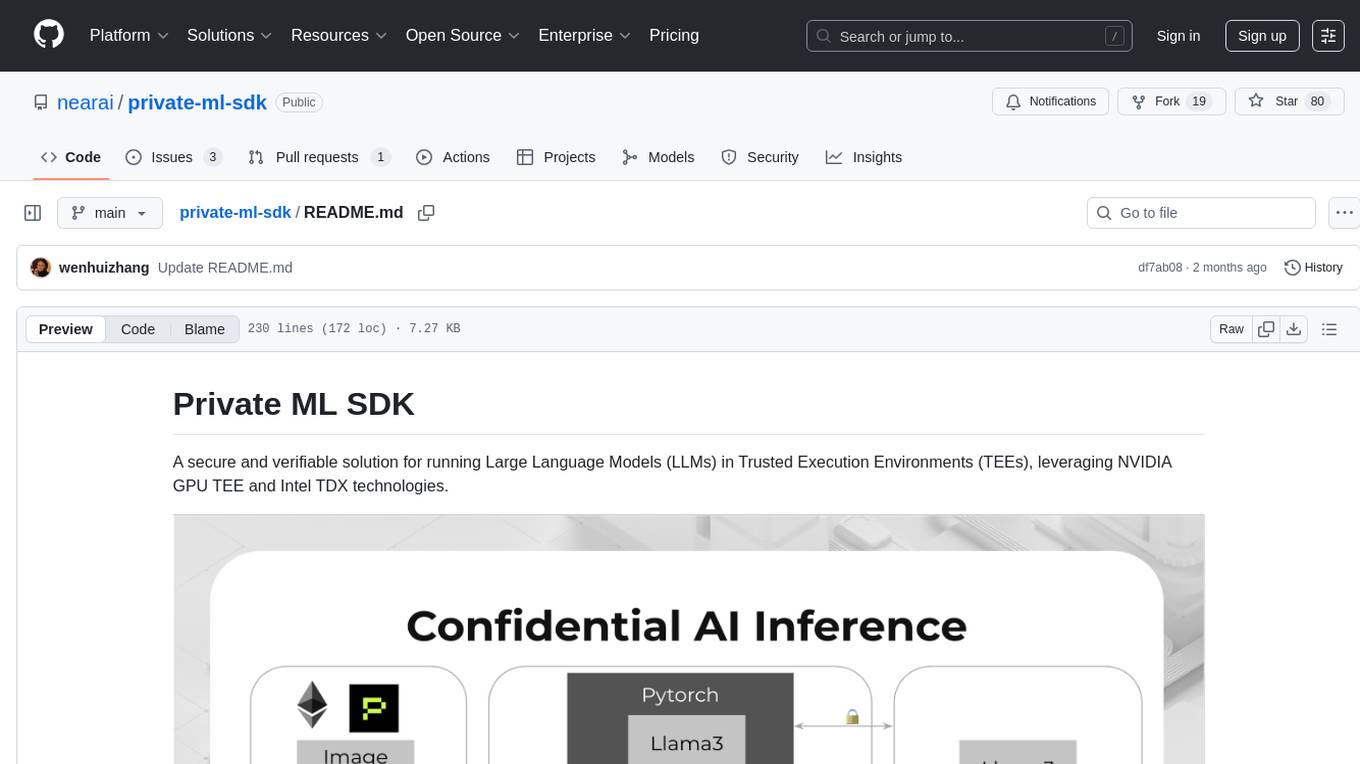
Private ML SDK is a secure solution for running Large Language Models (LLMs) in Trusted Execution Environments (TEEs) using NVIDIA GPU TEE and Intel TDX technologies. It provides a tamper-proof data processing environment with secure execution, open-source builds, and nearly native speed performance. The system includes components like Secure Compute Environment, Remote Attestation, Secure Communication, and Key Management Service (KMS). Users can build TDX guest images, run Local KMS, and TDX guest images on TDX host machines with Nvidia GPUs. The SDK offers verifiable execution results and high performance for LLM workloads.
README:
A secure and verifiable solution for running Large Language Models (LLMs) in Trusted Execution Environments (TEEs), leveraging NVIDIA GPU TEE and Intel TDX technologies.
Private ML SDK provides a secure environment for running LLM workloads with guaranteed privacy and security, preventing unauthorized access to both the model and user data during inference operations. The solution leverages NVIDIA's TEE GPU technology (H100/H200/B100) and Intel CPUs with TDX support to ensure that AI model execution and data processing remain fully protected within secure enclaves.
Key features:
- Tamper-proof data processing
- Secure execution environment
- Open source and reproducible builds
- Verifiable execution results
- Nearly native speed performance (up to 99% efficiency)
The system consists of several core components:
- Secure Compute Environment: TEE-based execution environment
- Remote Attestation: Verification of the TEE environment
- Secure Communication: End-to-end encryption between users and LLM
- Key Management Service (KMS): Key management service to manage keys for encryption and decryption
Prerequisites:
- Install Docker:
curl -fsSL https://get.docker.com -o get-docker.sh sudo sh get-docker.sh
- Add the current user to the docker group:
sudo usermod -aG docker $USER newgrp docker # Apply group changes without logout
- Verify Docker installation:
docker --version docker run hello-world
Clone the repository and build the TDX guest image:
git clone https://github.com/nearai/private-ml-sdk --recursive
cd private-ml-sdk/
./build.sh
If everything goes well, you should see the images files in private-ml-sdk/images/.
There are two image directories:
-
dstack-nvidia-0.5.3/: the production image without developer tools. -
dstack-nvidia-dev-0.5.3/: the development image with developer tools, such assshd,strace.
Before launching the CVM, ensure that the Local KMS is operational, as it provides the essential keys required for the proper initialization of the CVM. These keys are derived from the local TEE hardware environment.
The Local KMS service can be launched by following commands:
cd private-ml-sdk/meta-dstack-nvidia/dstack/key-provider-build/
./run.shThis requires a TDX host machine with the TDX driver installed and Nvidia GPU what support GPU TEE installed.
# Add the scripts/bin directory to the PATH environment variable
pushd private-ml-sdk/meta-dstack-nvidia/scripts/bin
PATH=$PATH:`pwd`
popd
# List the Available GPUs
dstack lsgpu
# Output like the following:
# Available GPU IDs:
# ID Description
# 18:00.0 3D controller: NVIDIA Corporation GH100 [H200 SXM 141GB] (rev a1)
# 2a:00.0 3D controller: NVIDIA Corporation GH100 [H200 SXM 141GB] (rev a1)
# 3a:00.0 3D controller: NVIDIA Corporation GH100 [H200 SXM 141GB] (rev a1)
# 5d:00.0 3D controller: NVIDIA Corporation GH100 [H200 SXM 141GB] (rev a1)
# 9a:00.0 3D controller: NVIDIA Corporation GH100 [H200 SXM 141GB] (rev a1)
# ab:00.0 3D controller: NVIDIA Corporation GH100 [H200 SXM 141GB] (rev a1)
# ba:00.0 3D controller: NVIDIA Corporation GH100 [H200 SXM 141GB] (rev a1)
# db:00.0 3D controller: NVIDIA Corporation GH100 [H200 SXM 141GB] (rev a1)
# Choose one or more GPU IDs and run the following command to create a CVM instance
dstack new app.yaml -o my-gpu-cvm \
--local-key-provider \
--gpu 18:00.0 \
--image images/dstack-nvidia-dev-0.5.3 \
-c 2 -m 4G -d 100G \
--port tcp:127.0.0.1:10022:22 \
--port tcp:0.0.0.0:8888:8888
# Run the CVM:
sudo -E dstack run my-gpu-cvm
An example of the app.yaml file is as follows:
# app.yaml
services:
jupyter:
image: kvin/cuda-notebook
privileged: true
ports:
- "8888:8888"
volumes:
- /var/run/tappd.sock:/var/run/tappd.sock
deploy:
resources:
reservations:
devices:
- driver: nvidia
count: all
capabilities: [gpu]
runtime: nvidia-
SSH into the CVM Note: SSH access is only available when using the development image
images/dstack-nvidia-dev-*.Execute the following command to establish an SSH connection:
ssh -p 10022 root@localhost
Note: Port 10022 is mapped to the CVM's port 22 during the creation of the CVM.
After logging in, check the status of the Docker Compose services by running:
docker ps -a
-
Verify the Jupyter Service Status To confirm that the Docker Compose services are running correctly, access the Jupyter service through your web browser:
-
For local access, navigate to: http://localhost:8888 (Port 8888 is mapped to the CVM's port 8888 during the creation of the CVM.)
-
For remote access, use the following URL: http://:8888 (Replace
<public-ip>with the actual public IP address of your CVM.)
-
To update the environment variables for the TDX CVM, execute the following command:
cp env-file <your-cvm-path>/shared/env-fileThe env-file is a text file that contains the necessary environment variables for the Docker Compose services. An example of the contents of the env-file is as follows:
# env-file
REDPILL_API_KEY=sk-1234567890
REDPILL_MODEL=phala/llama-3.3-70b-instruct
After copying the env-file, restart the CVM. The environment variables specified in the env-file will be accessible within the Docker Compose service YAML. During the boot process, this env-file is copied to the /tapp/env-file directory within the CVM.
For instance, in your docker-compose.yaml, you can reference the env-file as shown below:
# docker-compose.yaml, using the Jupyter service as an example
services:
jupyter:
env_file:
- /tapp/env-fileThis approach ensures that your environment variables are properly configured and accessible to your services.
- Install the SDK package:
pip install dstack-sdk- Get TDX quote using Python:
from dstack_sdk import TappdClient
# Initialize the client
client = TappdClient()
# Get quote for a message
result = client.tdx_quote('test')
print(result.quote)Based on benchmarks running LLMs in NVIDIA H100 and H200:
- Efficiency approaches 99% as input size grows
- Minimal overhead for larger models (e.g., Phi3-14B-128k and Llama3.1-70B)
- Performance scales well with increased input sizes and model complexities
- I/O overhead becomes negligible in high-computation scenarios
This project is licensed under the MIT License - see the LICENSE file for details.
Contributions are welcome! Please feel free to submit a Pull Request.
For Tasks:
Click tags to check more tools for each tasksFor Jobs:
Alternative AI tools for private-ml-sdk
Similar Open Source Tools

private-ml-sdk
Private ML SDK is a secure solution for running Large Language Models (LLMs) in Trusted Execution Environments (TEEs) using NVIDIA GPU TEE and Intel TDX technologies. It provides a tamper-proof data processing environment with secure execution, open-source builds, and nearly native speed performance. The system includes components like Secure Compute Environment, Remote Attestation, Secure Communication, and Key Management Service (KMS). Users can build TDX guest images, run Local KMS, and TDX guest images on TDX host machines with Nvidia GPUs. The SDK offers verifiable execution results and high performance for LLM workloads.
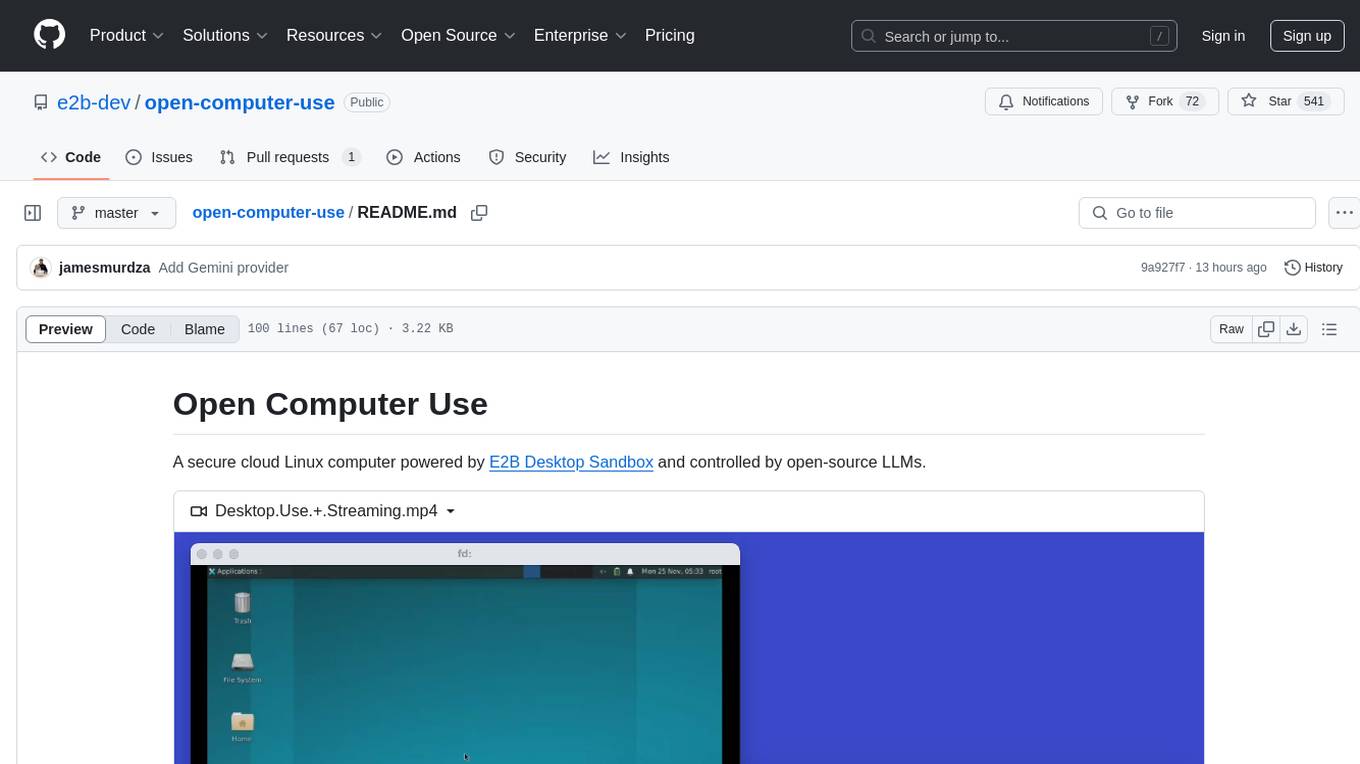
open-computer-use
Open Computer Use is a secure cloud Linux computer powered by E2B Desktop Sandbox and controlled by open-source LLMs. It allows users to operate the computer via keyboard, mouse, and shell commands, live stream the display of the sandbox on the client computer, and pause or prompt the agent at any time. The tool is designed to work with any operating system and supports integration with various LLMs and providers following the OpenAI API specification.
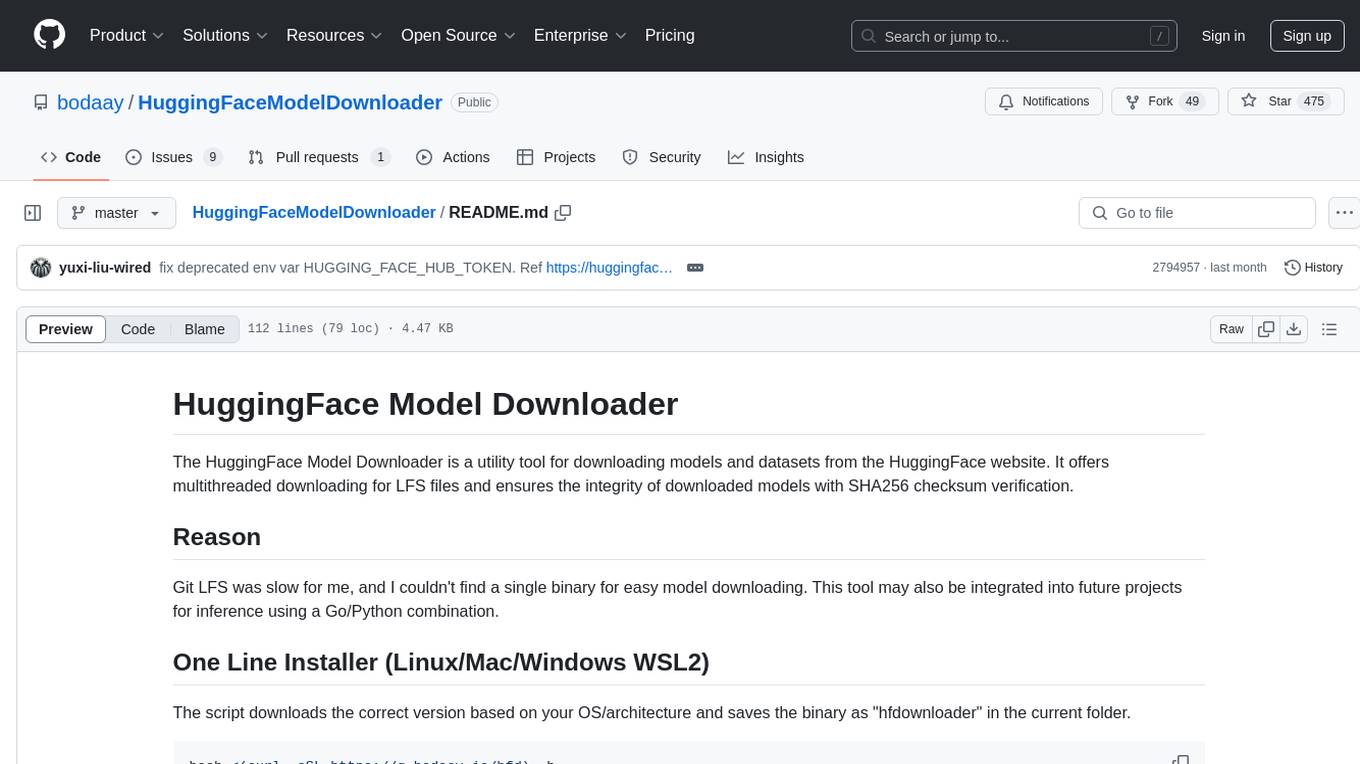
HuggingFaceModelDownloader
The HuggingFace Model Downloader is a utility tool for downloading models and datasets from the HuggingFace website. It offers multithreaded downloading for LFS files and ensures the integrity of downloaded models with SHA256 checksum verification. The tool provides features such as nested file downloading, filter downloads for specific LFS model files, support for HuggingFace Access Token, and configuration file support. It can be used as a library or a single binary for easy model downloading and inference in projects.
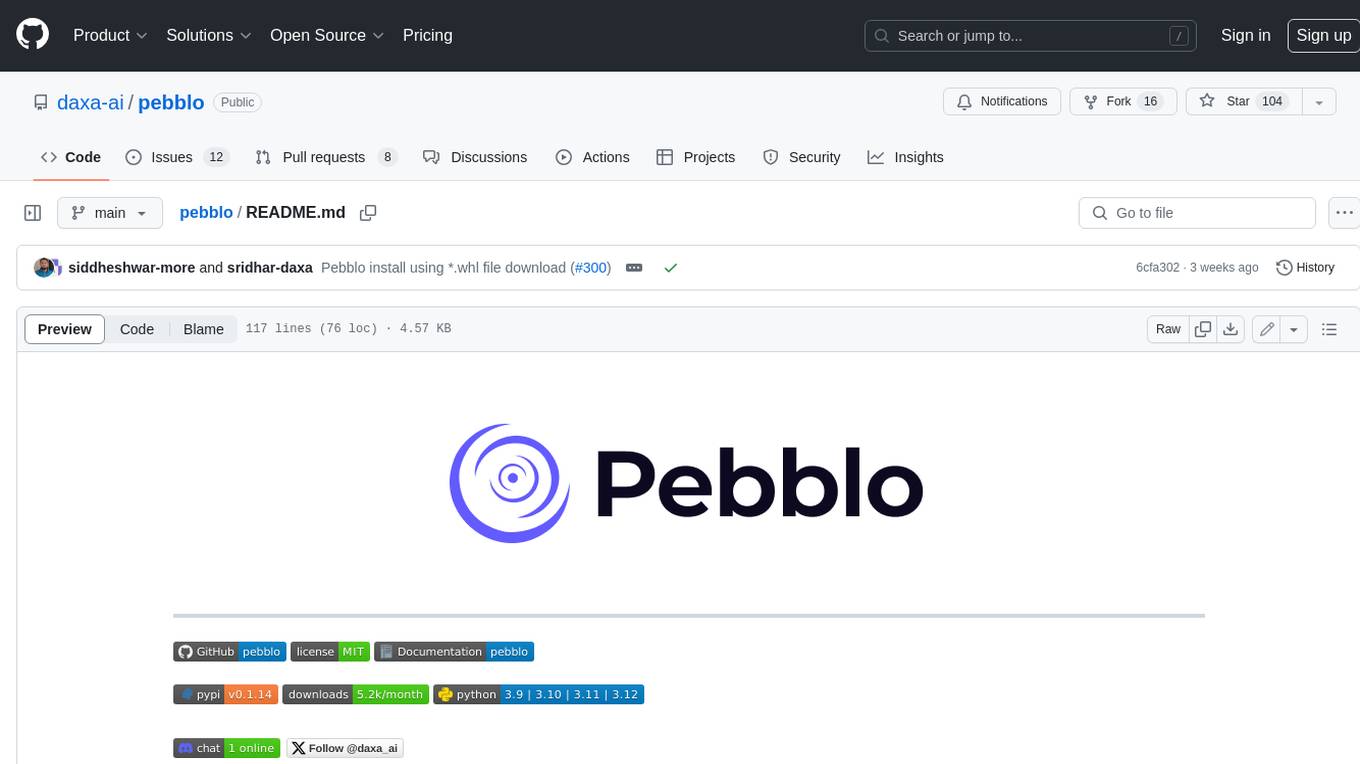
pebblo
Pebblo enables developers to safely load data and promote their Gen AI app to deployment without worrying about the organization’s compliance and security requirements. The project identifies semantic topics and entities found in the loaded data and summarizes them on the UI or a PDF report.
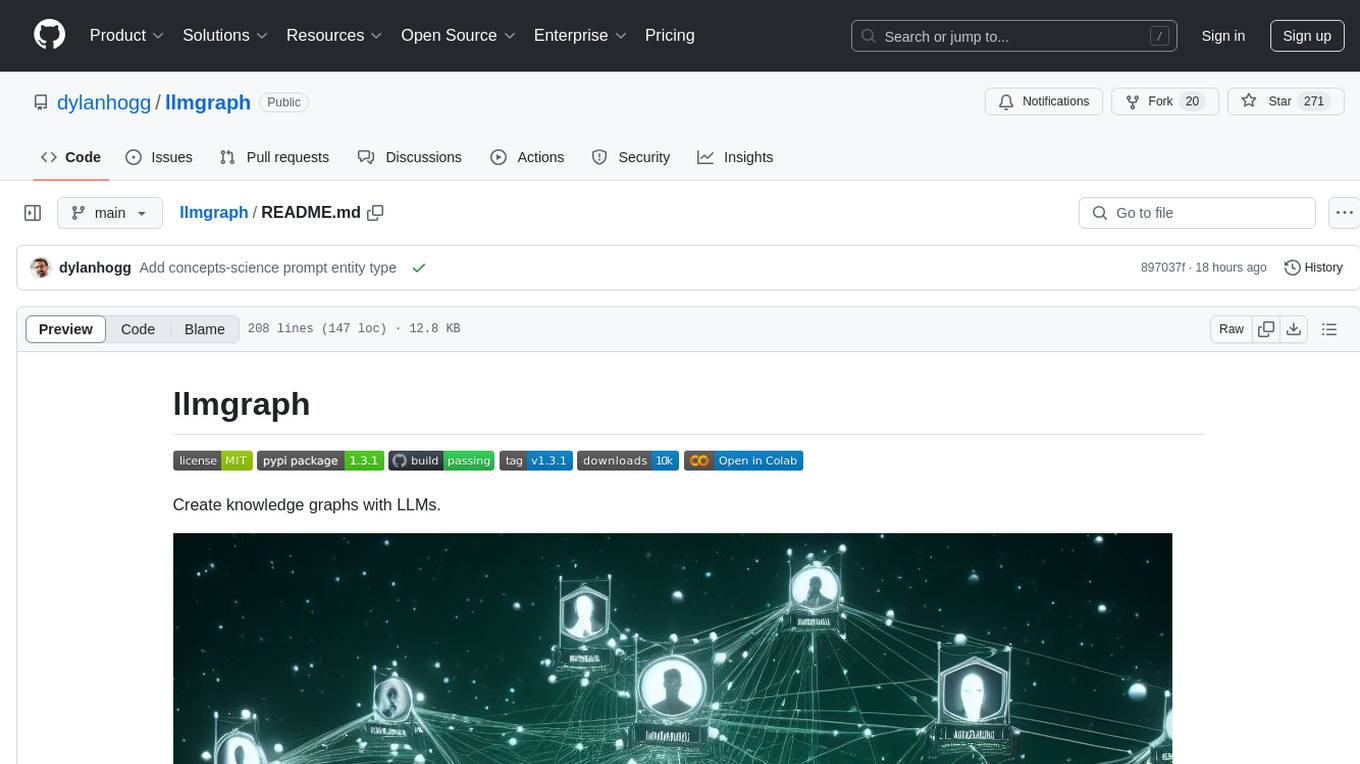
llmgraph
llmgraph is a tool that enables users to create knowledge graphs in GraphML, GEXF, and HTML formats by extracting world knowledge from large language models (LLMs) like ChatGPT. It supports various entity types and relationships, offers cache support for efficient graph growth, and provides insights into LLM costs. Users can customize the model used and interact with different LLM providers. The tool allows users to generate interactive graphs based on a specified entity type and Wikipedia link, making it a valuable resource for knowledge graph creation and exploration.
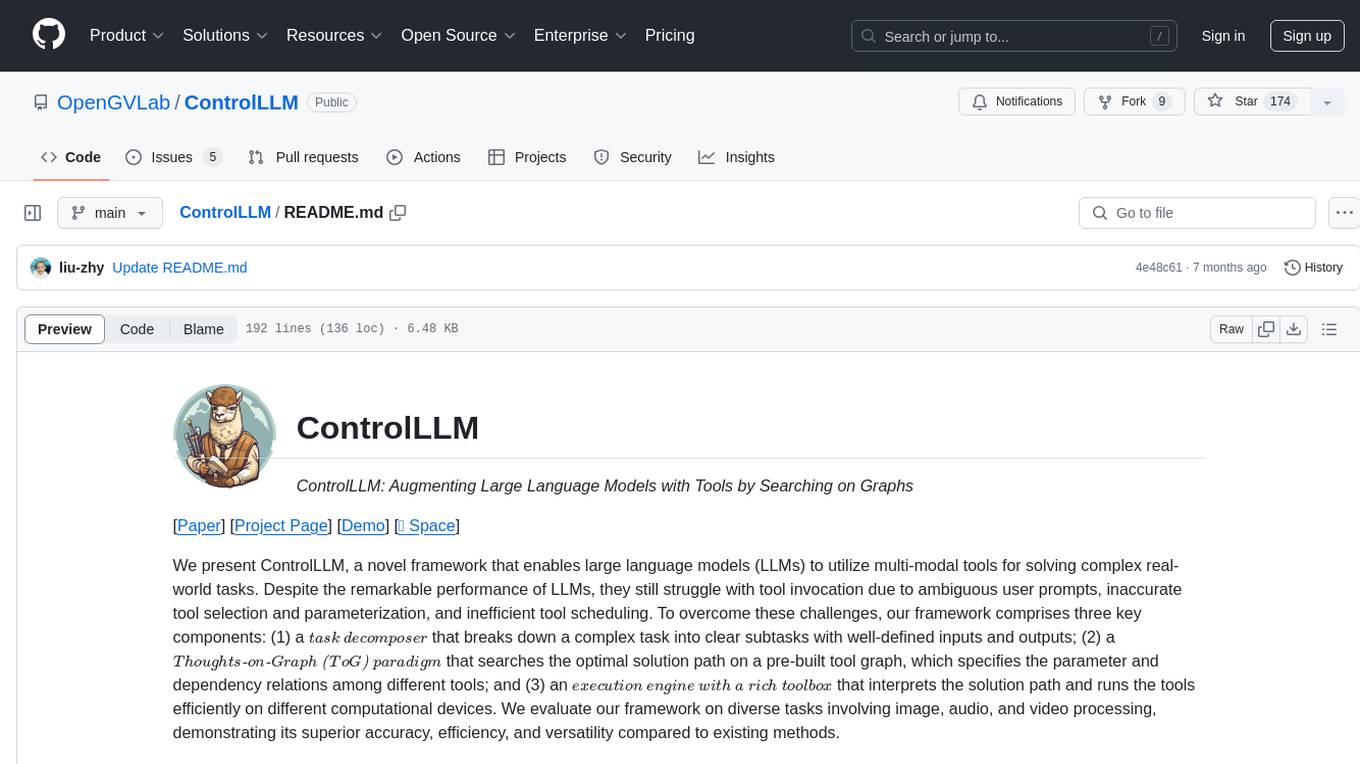
ControlLLM
ControlLLM is a framework that empowers large language models to leverage multi-modal tools for solving complex real-world tasks. It addresses challenges like ambiguous user prompts, inaccurate tool selection, and inefficient tool scheduling by utilizing a task decomposer, a Thoughts-on-Graph paradigm, and an execution engine with a rich toolbox. The framework excels in tasks involving image, audio, and video processing, showcasing superior accuracy, efficiency, and versatility compared to existing methods.
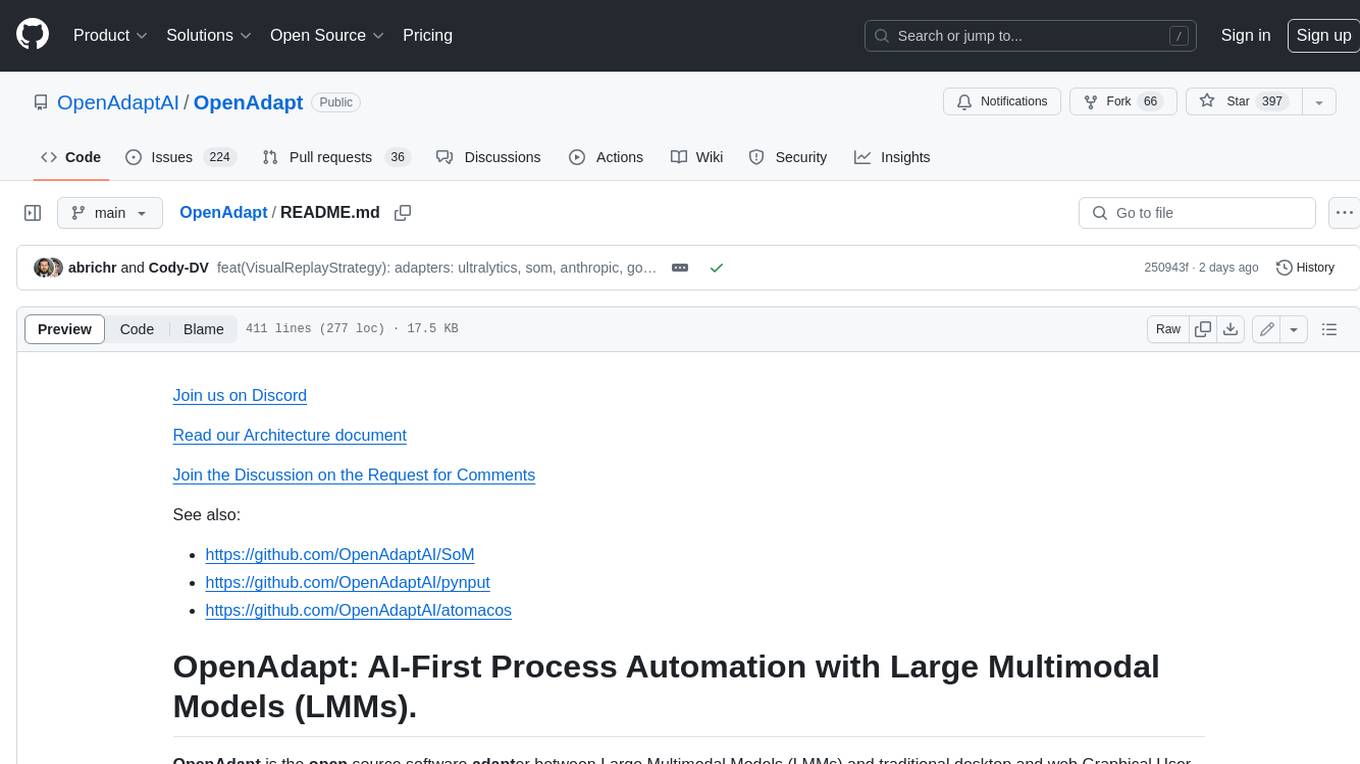
OpenAdapt
OpenAdapt is an open-source software adapter between Large Multimodal Models (LMMs) and traditional desktop and web Graphical User Interfaces (GUIs). It aims to automate repetitive GUI workflows by leveraging the power of LMMs. OpenAdapt records user input and screenshots, converts them into tokenized format, and generates synthetic input via transformer model completions. It also analyzes recordings to generate task trees and replay synthetic input to complete tasks. OpenAdapt is model agnostic and generates prompts automatically by learning from human demonstration, ensuring that agents are grounded in existing processes and mitigating hallucinations. It works with all types of desktop GUIs, including virtualized and web, and is open source under the MIT license.
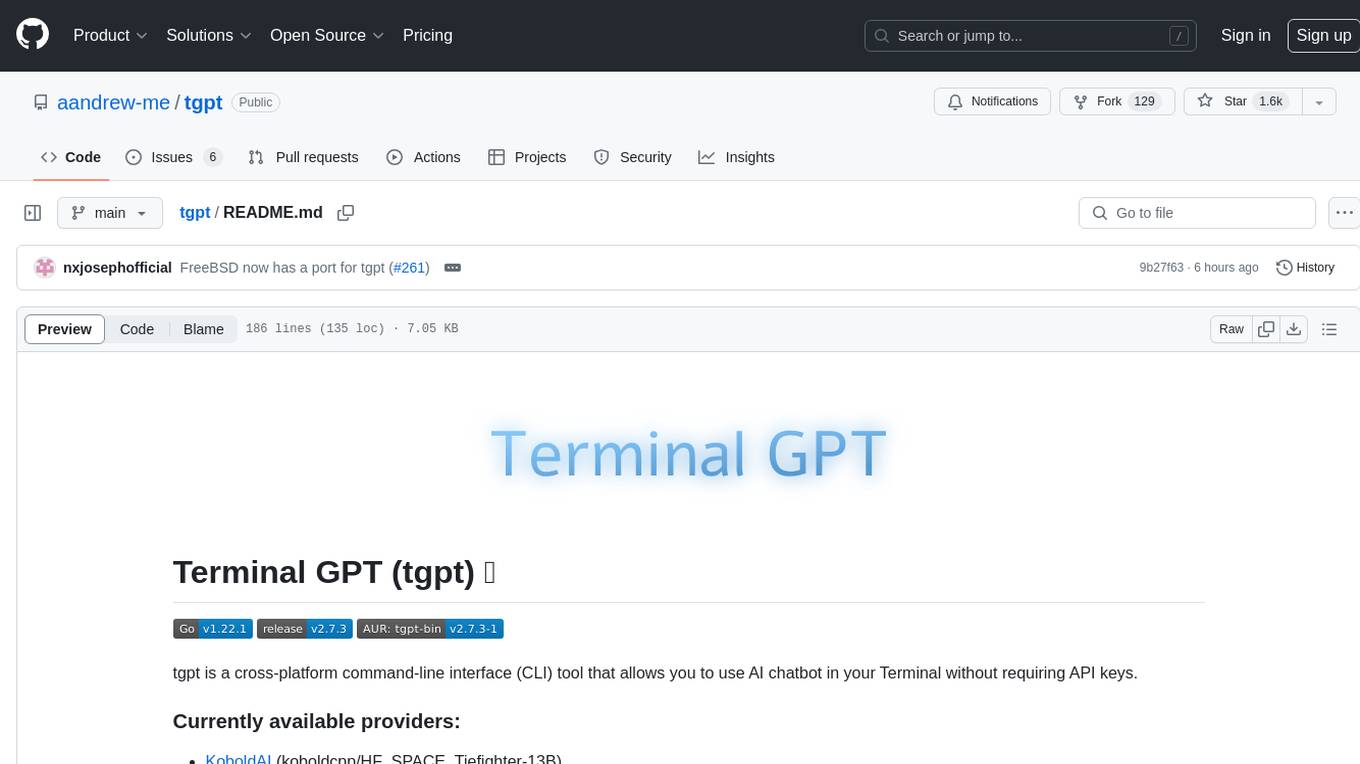
tgpt
tgpt is a cross-platform command-line interface (CLI) tool that allows users to interact with AI chatbots in the Terminal without needing API keys. It supports various AI providers such as KoboldAI, Phind, Llama2, Blackbox AI, and OpenAI. Users can generate text, code, and images using different flags and options. The tool can be installed on GNU/Linux, MacOS, FreeBSD, and Windows systems. It also supports proxy configurations and provides options for updating and uninstalling the tool.
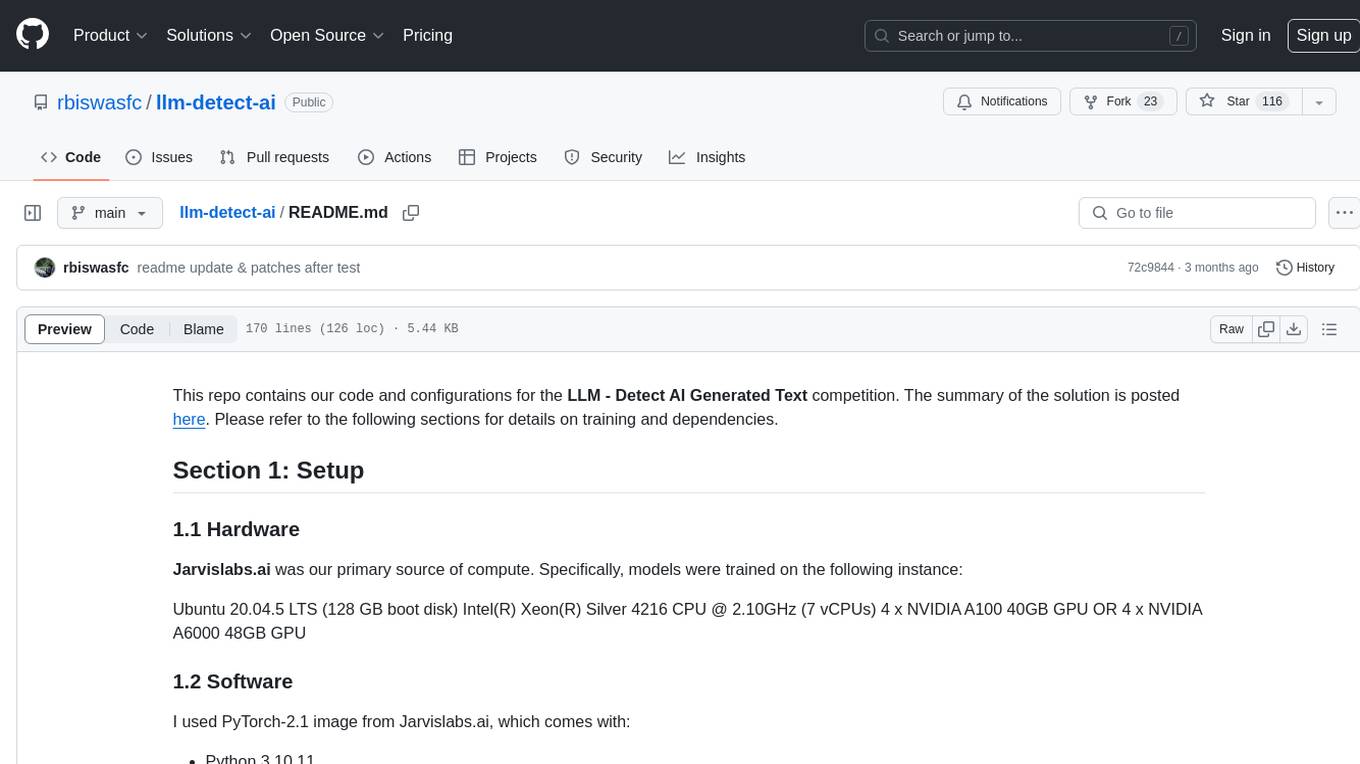
llm-detect-ai
This repository contains code and configurations for the LLM - Detect AI Generated Text competition. It includes setup instructions for hardware, software, dependencies, and datasets. The training section covers scripts and configurations for training LLM models, DeBERTa ranking models, and an embedding model. Text generation section details fine-tuning LLMs using the CLM objective on the PERSUADE corpus to generate student-like essays.
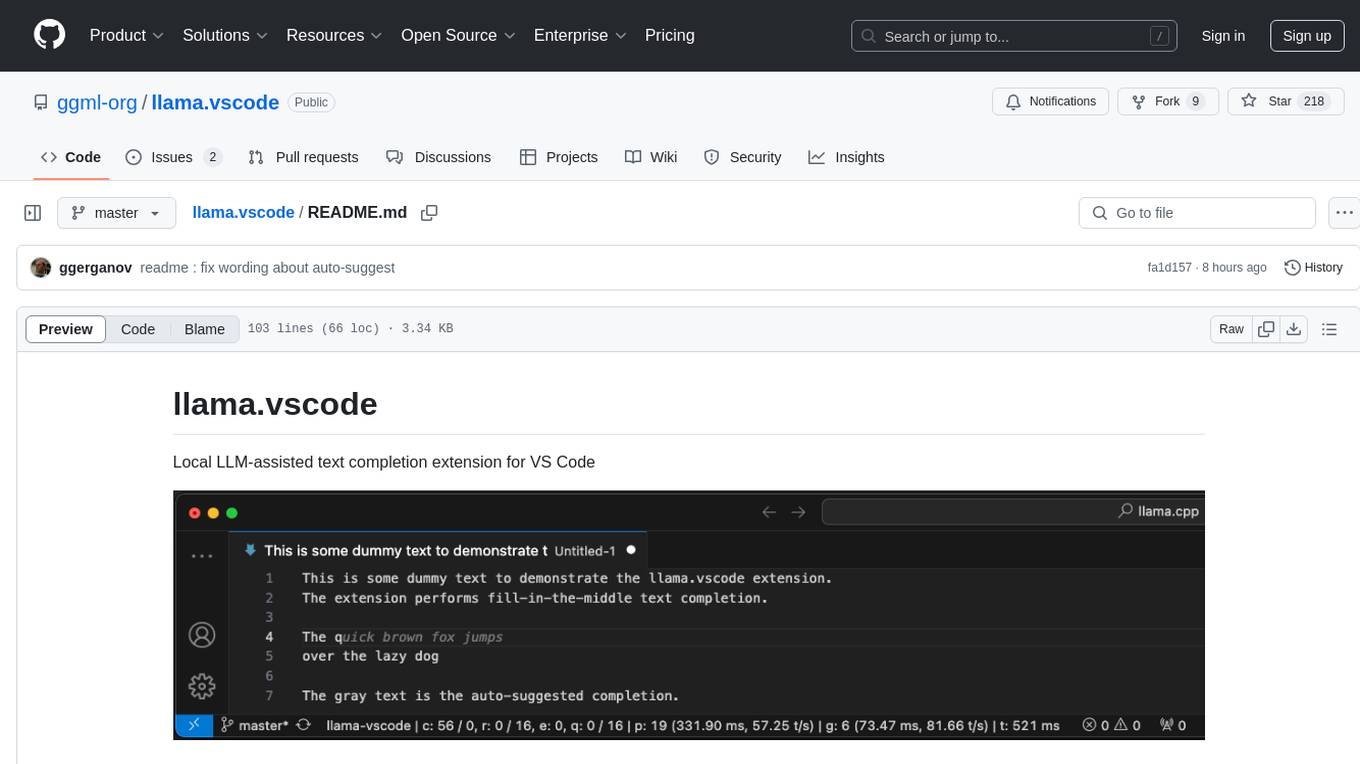
llama.vscode
llama.vscode is a local LLM-assisted text completion extension for Visual Studio Code. It provides auto-suggestions on input, allows accepting suggestions with shortcuts, and offers various features to enhance text completion. The extension is designed to be lightweight and efficient, enabling high-quality completions even on low-end hardware. Users can configure the scope of context around the cursor and control text generation time. It supports very large contexts and displays performance statistics for better user experience.
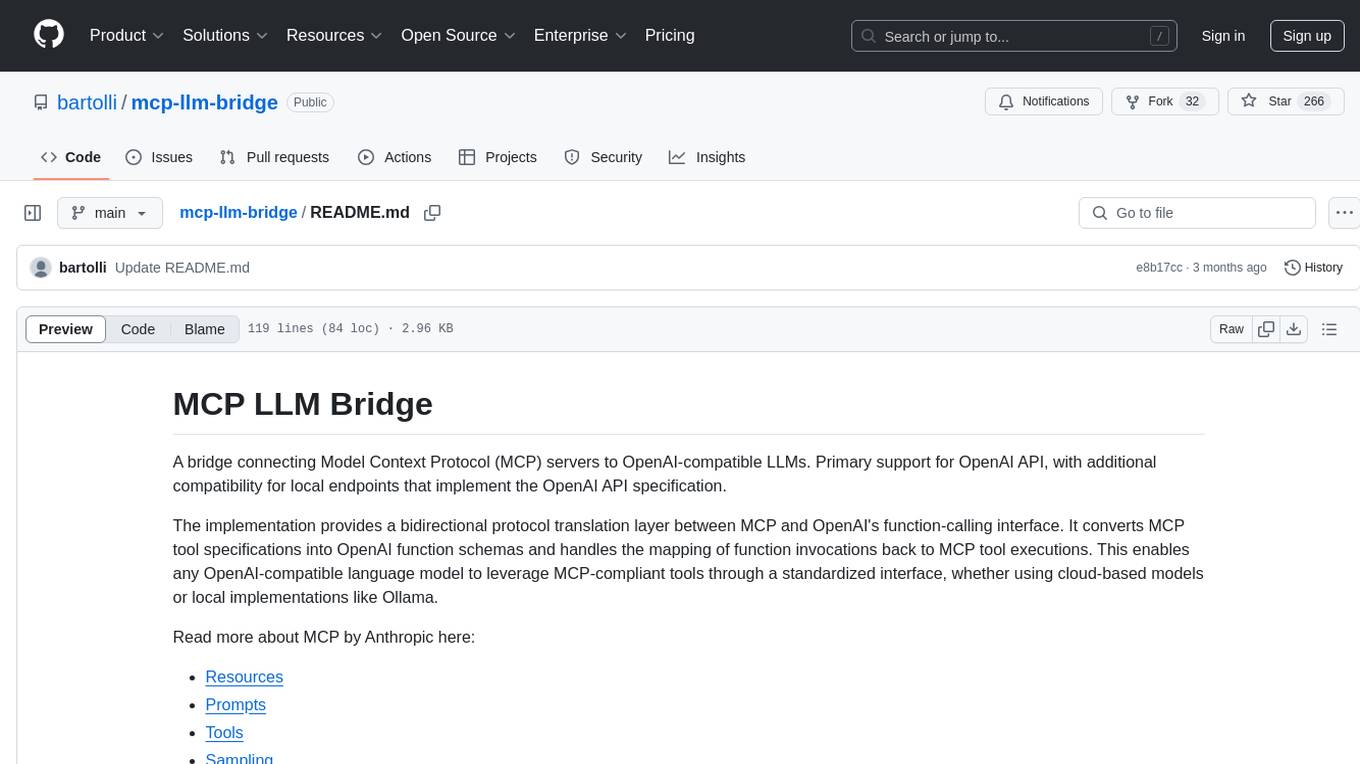
mcp-llm-bridge
The MCP LLM Bridge is a tool that acts as a bridge connecting Model Context Protocol (MCP) servers to OpenAI-compatible LLMs. It provides a bidirectional protocol translation layer between MCP and OpenAI's function-calling interface, enabling any OpenAI-compatible language model to leverage MCP-compliant tools through a standardized interface. The tool supports primary integration with the OpenAI API and offers additional compatibility for local endpoints that implement the OpenAI API specification. Users can configure the tool for different endpoints and models, facilitating the execution of complex queries and tasks using cloud-based or local models like Ollama and LM Studio.
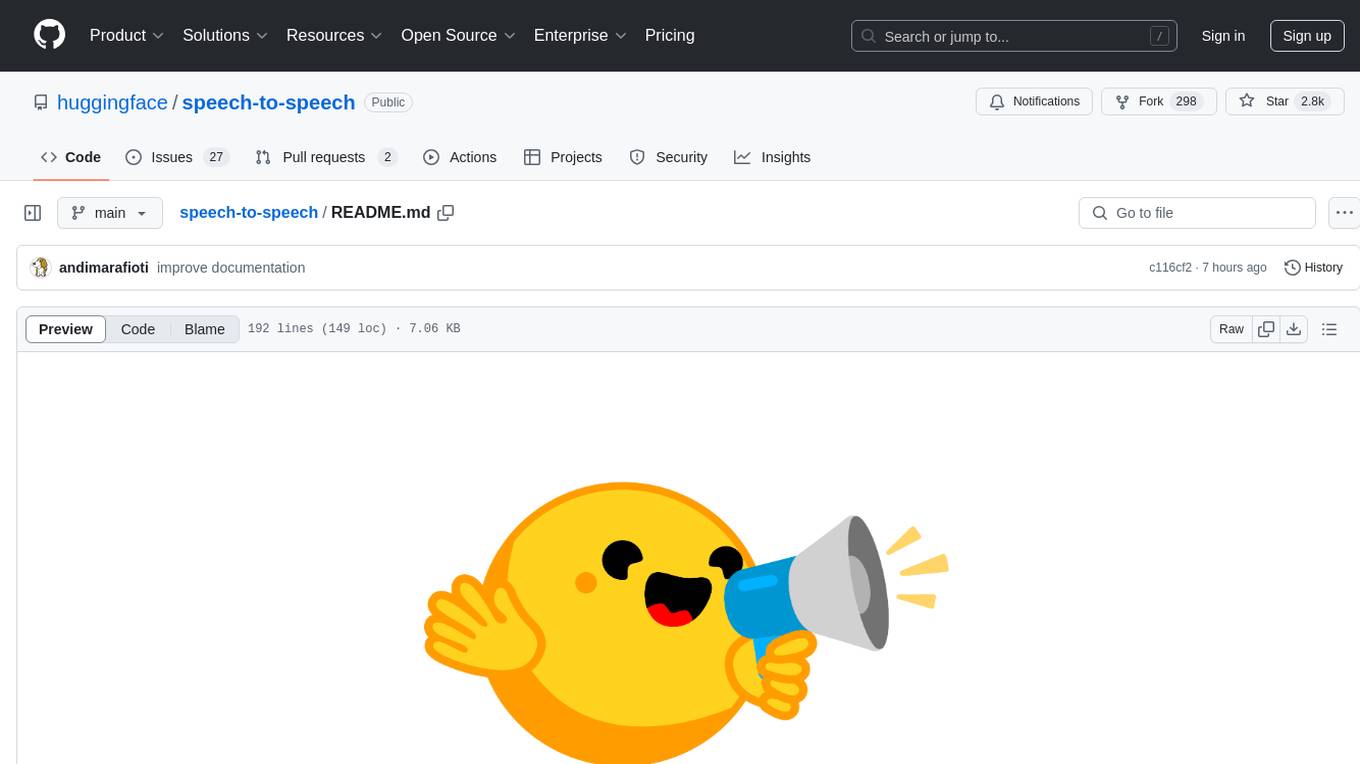
speech-to-speech
This repository implements a speech-to-speech cascaded pipeline with consecutive parts including Voice Activity Detection (VAD), Speech to Text (STT), Language Model (LM), and Text to Speech (TTS). It aims to provide a fully open and modular approach by leveraging models available on the Transformers library via the Hugging Face hub. The code is designed for easy modification, with each component implemented as a class. Users can run the pipeline either on a server/client approach or locally, with detailed setup and usage instructions provided in the readme.
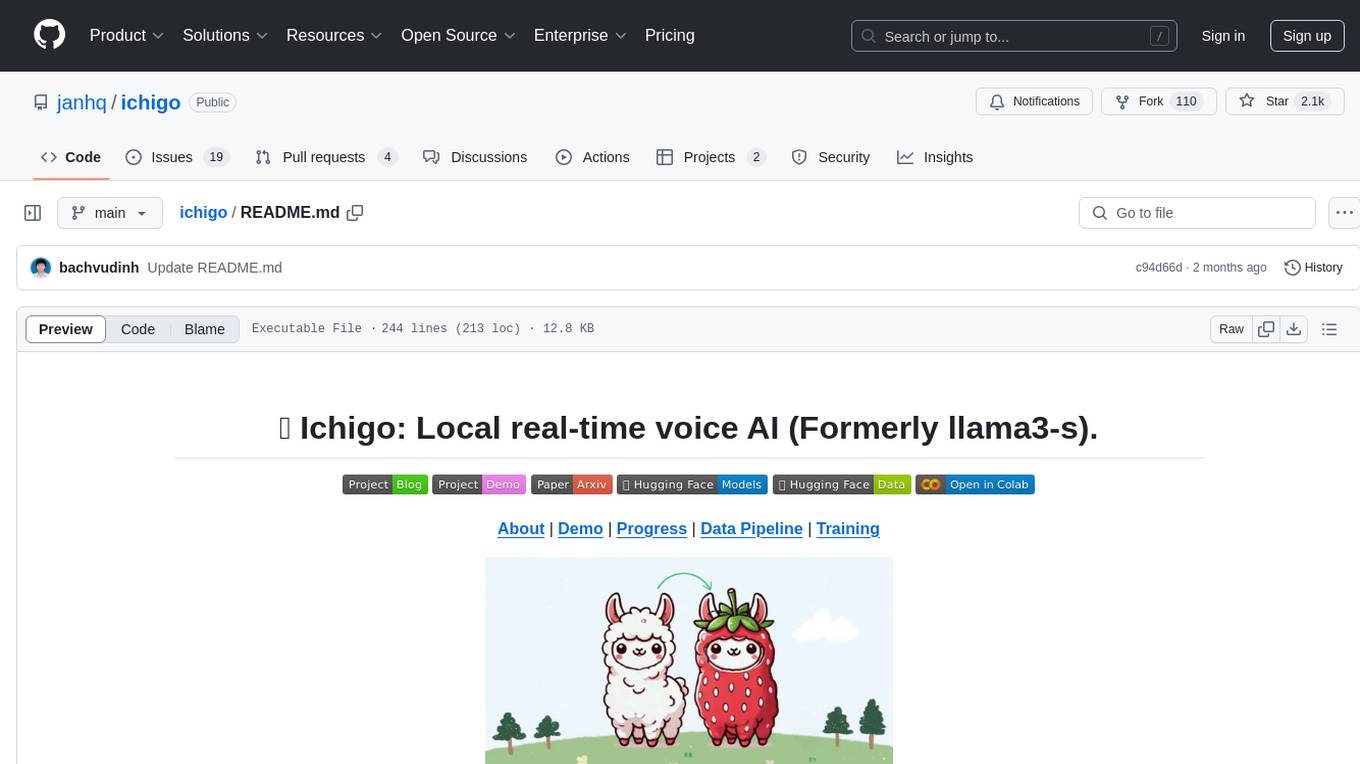
ichigo
Ichigo is a local real-time voice AI tool that uses an early fusion technique to extend a text-based LLM to have native 'listening' ability. It is an open research experiment with improved multiturn capabilities and the ability to refuse processing inaudible queries. The tool is designed for open data, open weight, on-device Siri-like functionality, inspired by Meta's Chameleon paper. Ichigo offers a web UI demo and Gradio web UI for users to interact with the tool. It has achieved enhanced MMLU scores, stronger context handling, advanced noise management, and improved multi-turn capabilities for a robust user experience.
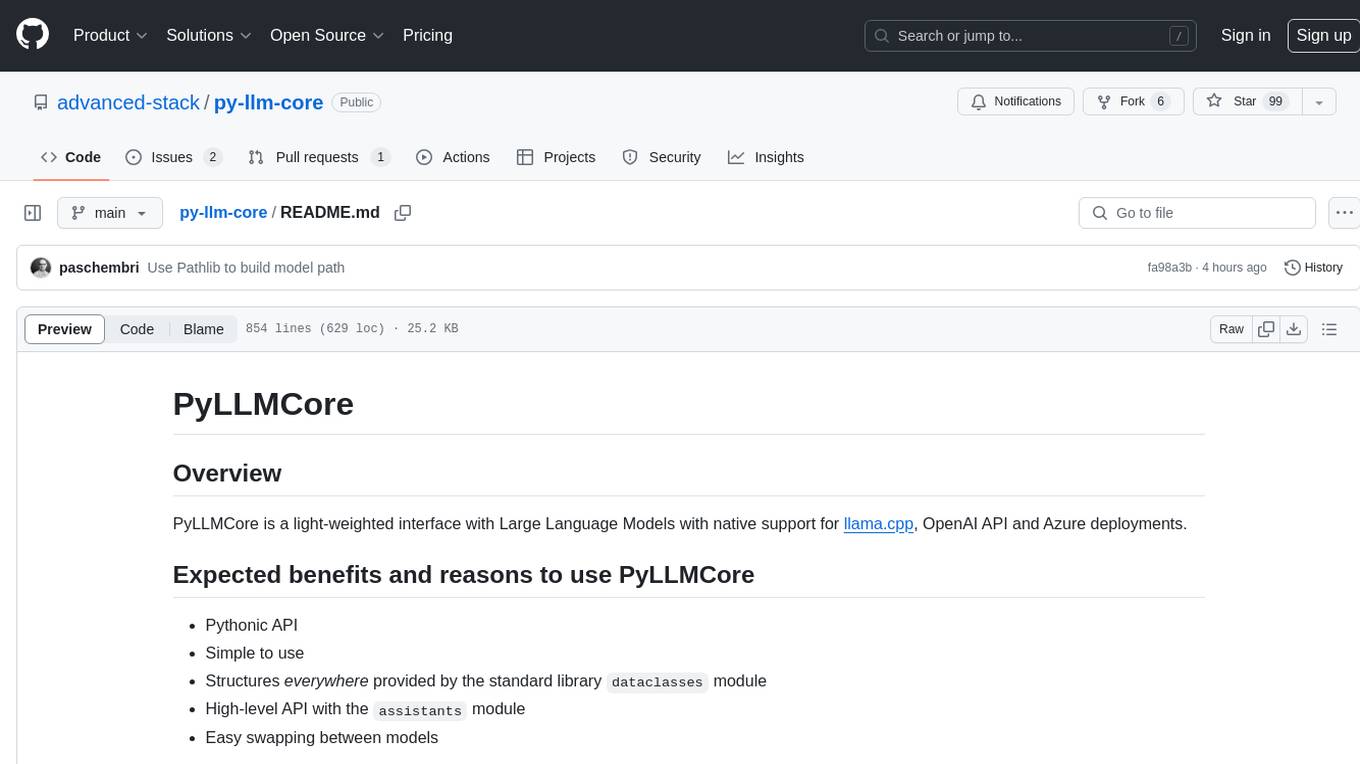
py-llm-core
PyLLMCore is a light-weighted interface with Large Language Models with native support for llama.cpp, OpenAI API, and Azure deployments. It offers a Pythonic API that is simple to use, with structures provided by the standard library dataclasses module. The high-level API includes the assistants module for easy swapping between models. PyLLMCore supports various models including those compatible with llama.cpp, OpenAI, and Azure APIs. It covers use cases such as parsing, summarizing, question answering, hallucinations reduction, context size management, and tokenizing. The tool allows users to interact with language models for tasks like parsing text, summarizing content, answering questions, reducing hallucinations, managing context size, and tokenizing text.
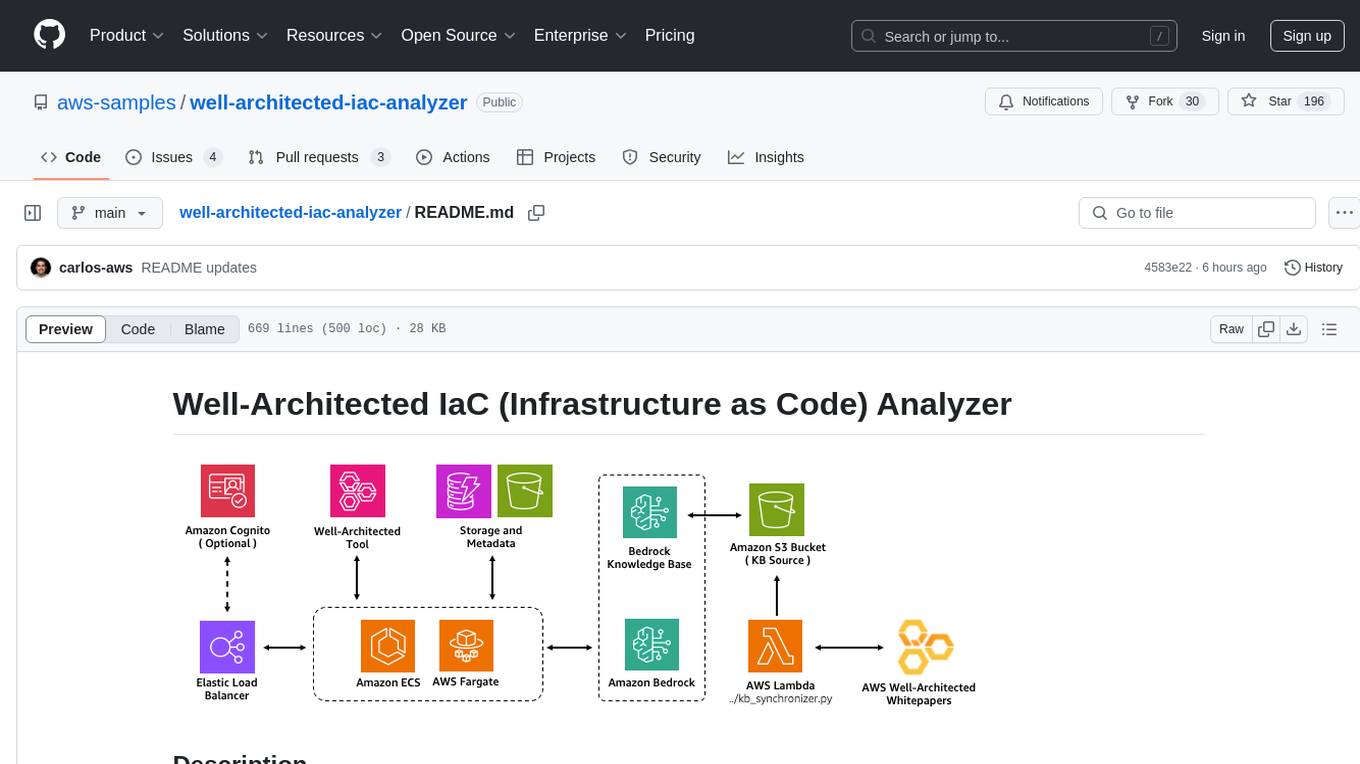
well-architected-iac-analyzer
Well-Architected Infrastructure as Code (IaC) Analyzer is a project demonstrating how generative AI can evaluate infrastructure code for alignment with best practices. It features a modern web application allowing users to upload IaC documents, complete IaC projects, or architecture diagrams for assessment. The tool provides insights into infrastructure code alignment with AWS best practices, offers suggestions for improving cloud architecture designs, and can generate IaC templates from architecture diagrams. Users can analyze CloudFormation, Terraform, or AWS CDK templates, architecture diagrams in PNG or JPEG format, and complete IaC projects with supporting documents. Real-time analysis against Well-Architected best practices, integration with AWS Well-Architected Tool, and export of analysis results and recommendations are included.
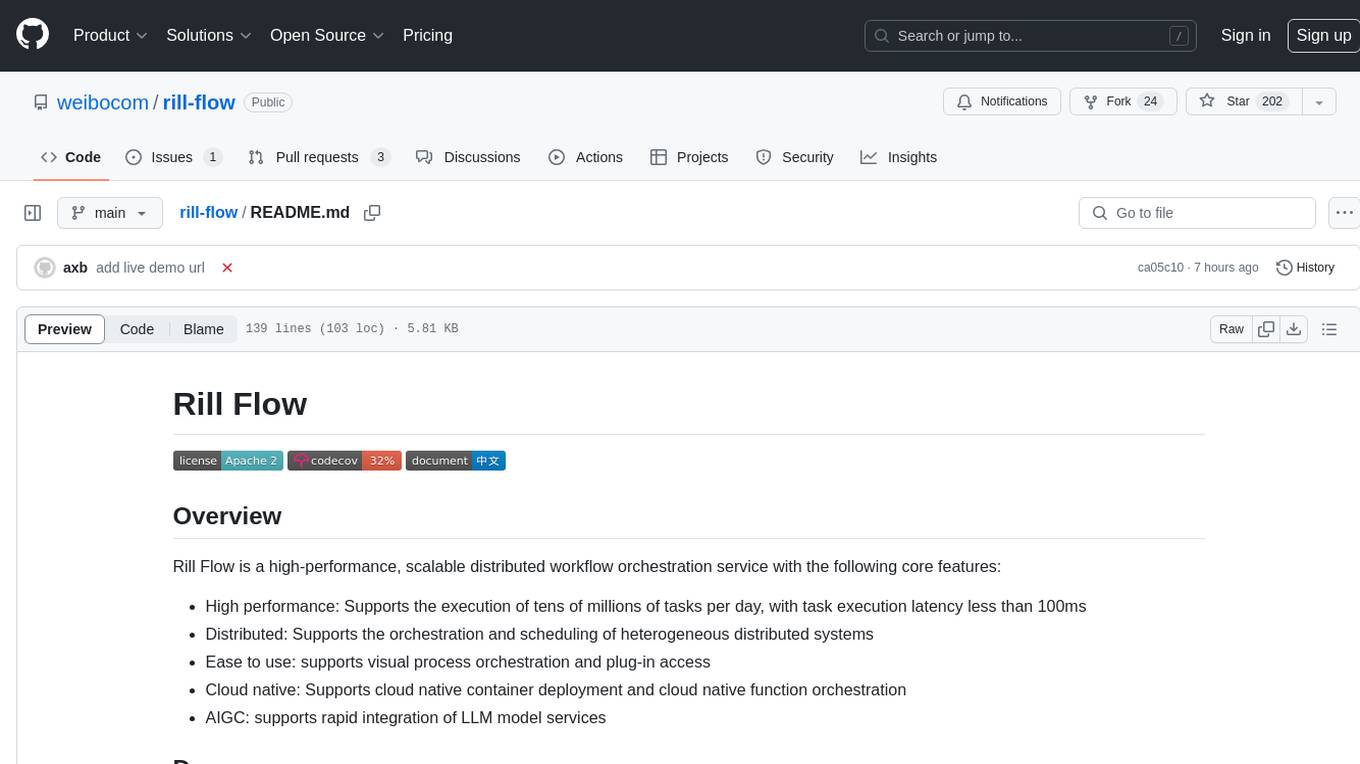
rill-flow
Rill Flow is a high-performance, scalable distributed workflow orchestration service that supports the execution of tens of millions of tasks per day with task execution latency less than 100ms. It is distributed and supports the orchestration and scheduling of heterogeneous distributed systems. Rill Flow is easy to use, supporting visual process orchestration and plug-in access. It is cloud native, allowing for cloud native container deployment and cloud native function orchestration. Additionally, Rill Flow supports rapid integration of LLM model services.
For similar tasks

private-ml-sdk
Private ML SDK is a secure solution for running Large Language Models (LLMs) in Trusted Execution Environments (TEEs) using NVIDIA GPU TEE and Intel TDX technologies. It provides a tamper-proof data processing environment with secure execution, open-source builds, and nearly native speed performance. The system includes components like Secure Compute Environment, Remote Attestation, Secure Communication, and Key Management Service (KMS). Users can build TDX guest images, run Local KMS, and TDX guest images on TDX host machines with Nvidia GPUs. The SDK offers verifiable execution results and high performance for LLM workloads.
For similar jobs

weave
Weave is a toolkit for developing Generative AI applications, built by Weights & Biases. With Weave, you can log and debug language model inputs, outputs, and traces; build rigorous, apples-to-apples evaluations for language model use cases; and organize all the information generated across the LLM workflow, from experimentation to evaluations to production. Weave aims to bring rigor, best-practices, and composability to the inherently experimental process of developing Generative AI software, without introducing cognitive overhead.
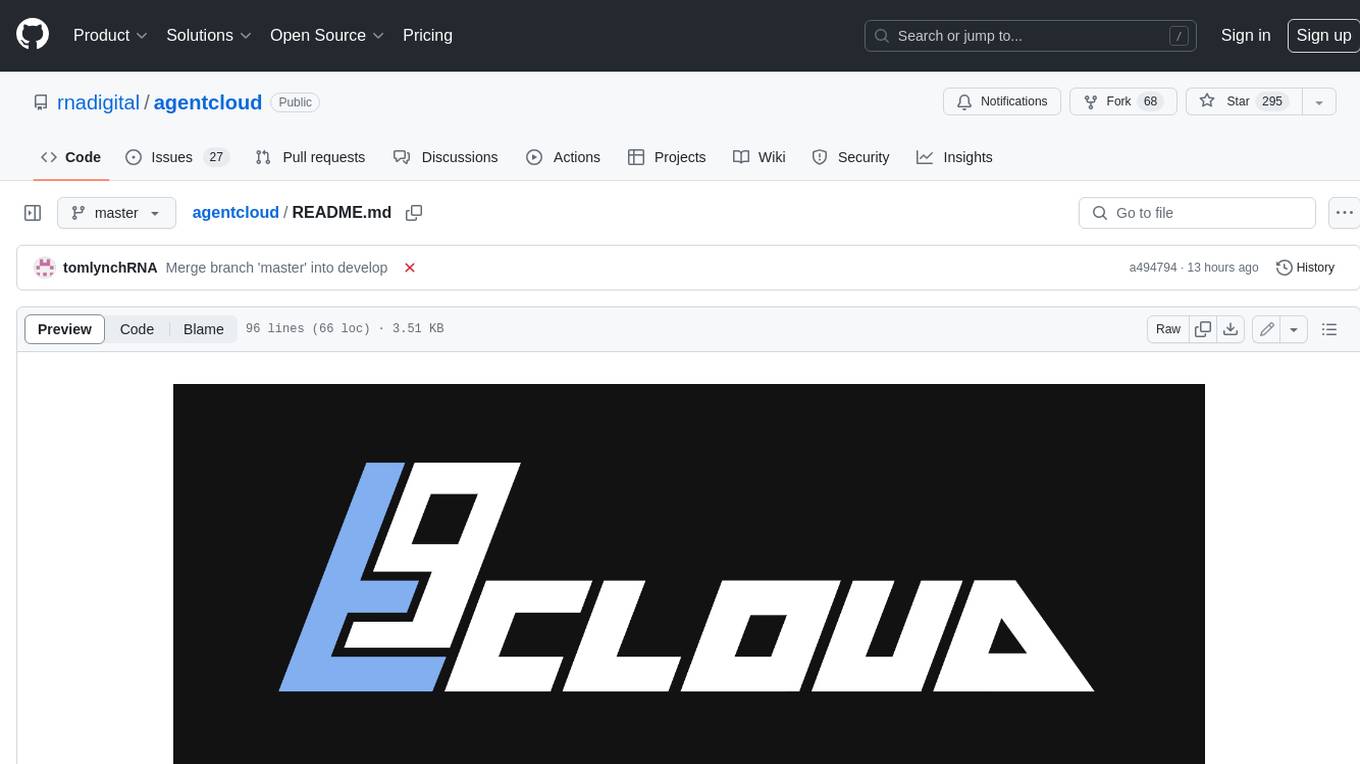
agentcloud
AgentCloud is an open-source platform that enables companies to build and deploy private LLM chat apps, empowering teams to securely interact with their data. It comprises three main components: Agent Backend, Webapp, and Vector Proxy. To run this project locally, clone the repository, install Docker, and start the services. The project is licensed under the GNU Affero General Public License, version 3 only. Contributions and feedback are welcome from the community.
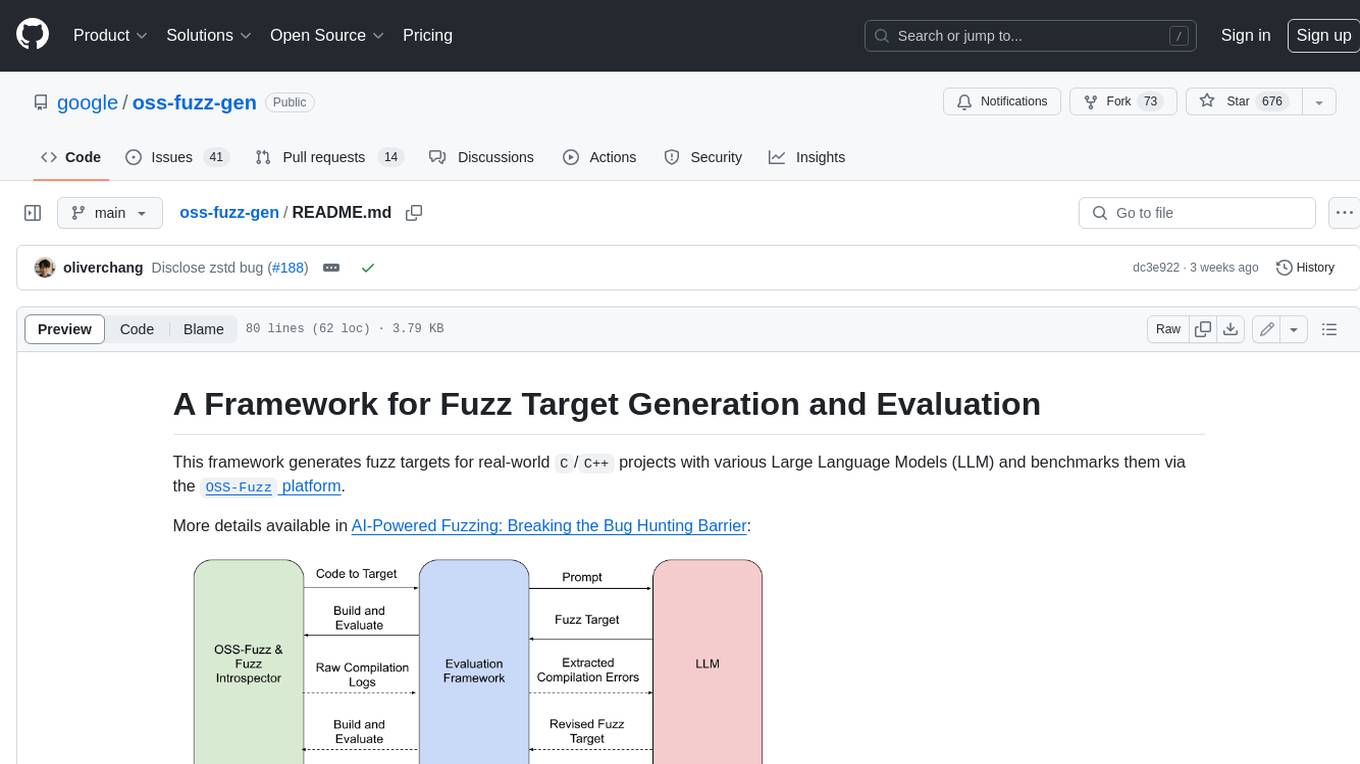
oss-fuzz-gen
This framework generates fuzz targets for real-world `C`/`C++` projects with various Large Language Models (LLM) and benchmarks them via the `OSS-Fuzz` platform. It manages to successfully leverage LLMs to generate valid fuzz targets (which generate non-zero coverage increase) for 160 C/C++ projects. The maximum line coverage increase is 29% from the existing human-written targets.

LLMStack
LLMStack is a no-code platform for building generative AI agents, workflows, and chatbots. It allows users to connect their own data, internal tools, and GPT-powered models without any coding experience. LLMStack can be deployed to the cloud or on-premise and can be accessed via HTTP API or triggered from Slack or Discord.

VisionCraft
The VisionCraft API is a free API for using over 100 different AI models. From images to sound.

kaito
Kaito is an operator that automates the AI/ML inference model deployment in a Kubernetes cluster. It manages large model files using container images, avoids tuning deployment parameters to fit GPU hardware by providing preset configurations, auto-provisions GPU nodes based on model requirements, and hosts large model images in the public Microsoft Container Registry (MCR) if the license allows. Using Kaito, the workflow of onboarding large AI inference models in Kubernetes is largely simplified.

PyRIT
PyRIT is an open access automation framework designed to empower security professionals and ML engineers to red team foundation models and their applications. It automates AI Red Teaming tasks to allow operators to focus on more complicated and time-consuming tasks and can also identify security harms such as misuse (e.g., malware generation, jailbreaking), and privacy harms (e.g., identity theft). The goal is to allow researchers to have a baseline of how well their model and entire inference pipeline is doing against different harm categories and to be able to compare that baseline to future iterations of their model. This allows them to have empirical data on how well their model is doing today, and detect any degradation of performance based on future improvements.
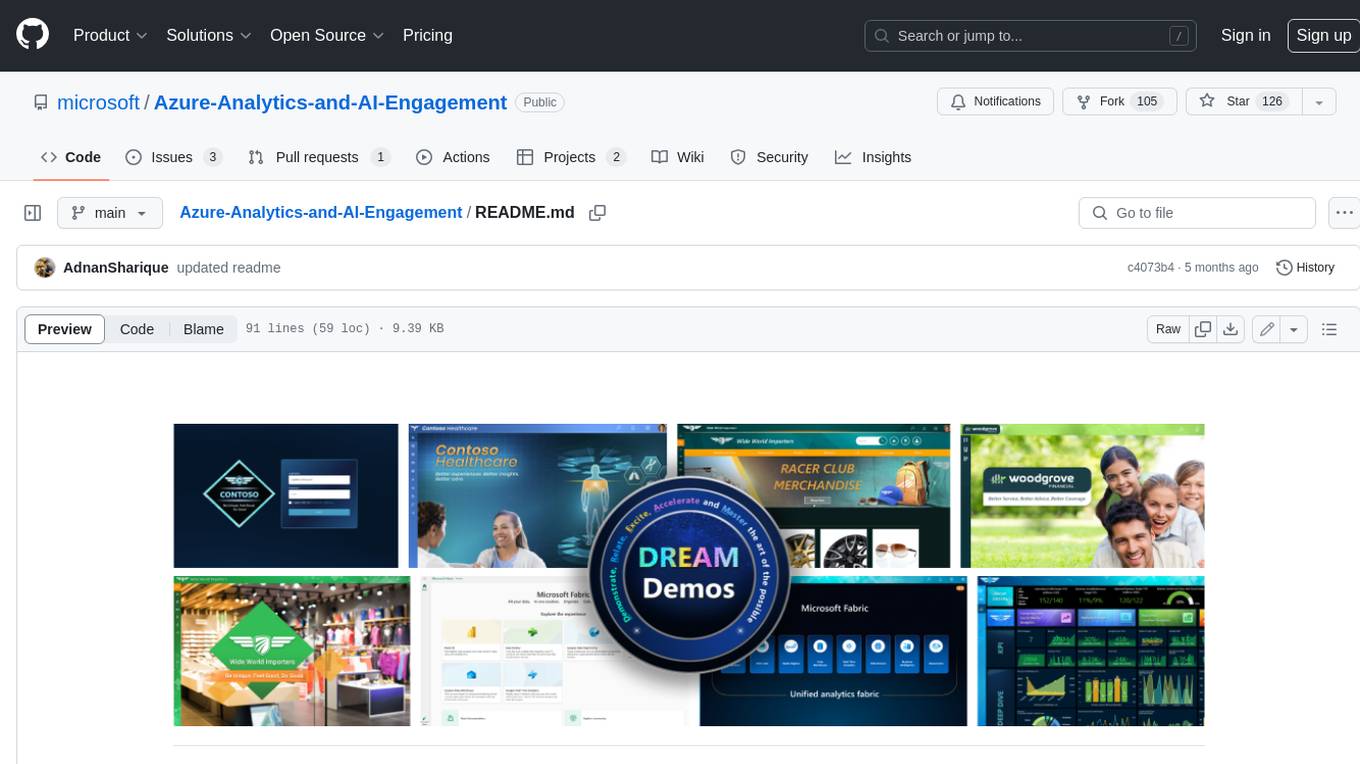
Azure-Analytics-and-AI-Engagement
The Azure-Analytics-and-AI-Engagement repository provides packaged Industry Scenario DREAM Demos with ARM templates (Containing a demo web application, Power BI reports, Synapse resources, AML Notebooks etc.) that can be deployed in a customer’s subscription using the CAPE tool within a matter of few hours. Partners can also deploy DREAM Demos in their own subscriptions using DPoC.
